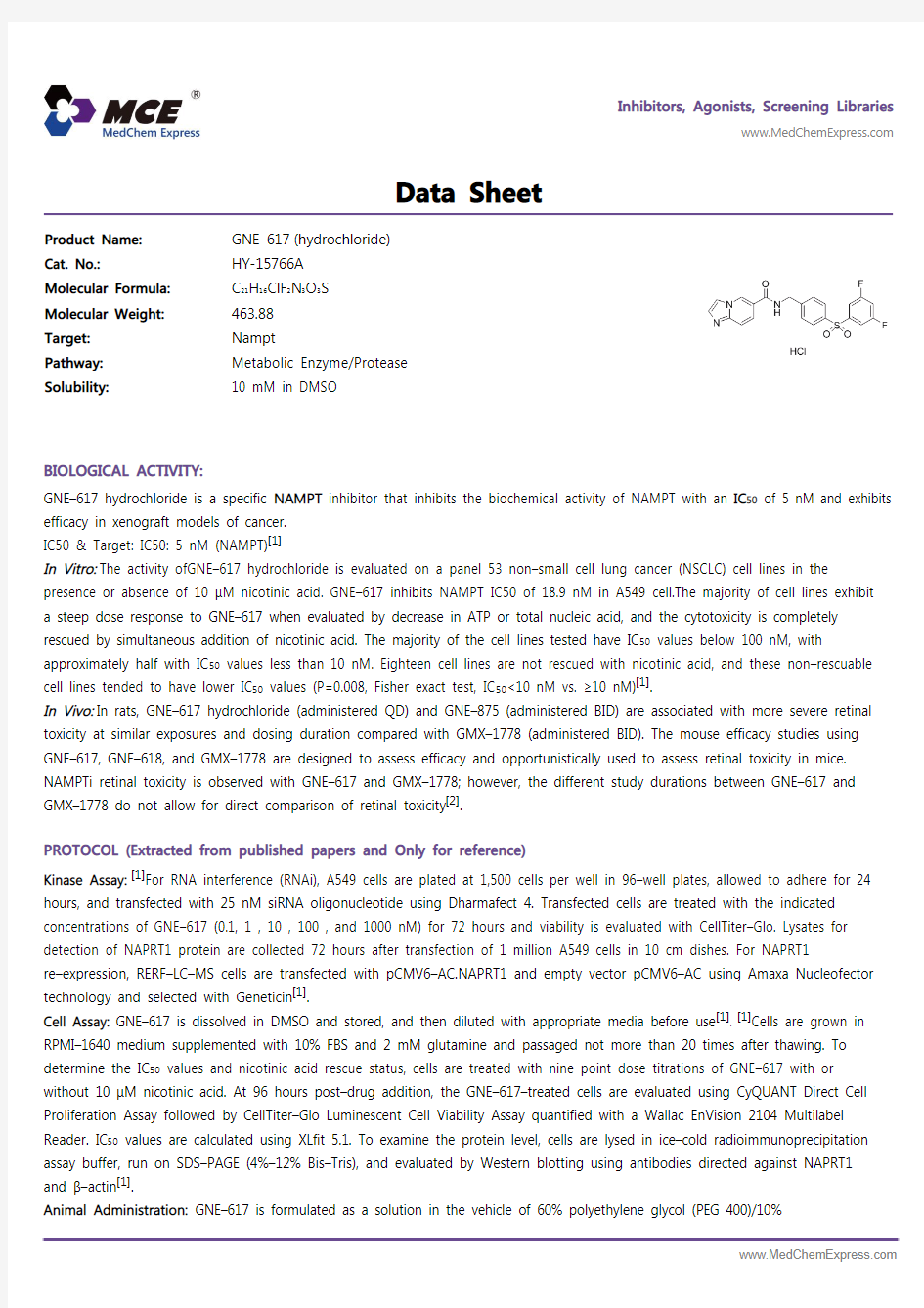GNE-617_hydrochloride_DataSheet_MedChemExpress


Inhibitors, Agonists, Screening Libraries
https://www.360docs.net/doc/6317494352.html, Data Sheet
BIOLOGICAL ACTIVITY:
GNE–617 hydrochloride is a specific NAMPT inhibitor that inhibits the biochemical activity of NAMPT with an IC 50 of 5 nM and exhibits efficacy in xenograft models of cancer.
IC50 & Target: IC50: 5 nM (NAMPT)[1]
In Vitro: The activity ofGNE–617 hydrochloride is evaluated on a panel 53 non–small cell lung cancer (NSCLC) cell lines in the
presence or absence of 10 μM nicotinic acid. GNE–617 inhibits NAMPT IC50 of 18.9 nM in A549 cell.The majority of cell lines exhibit a steep dose response to GNE–617 when evaluated by decrease in ATP or total nucleic acid, and the cytotoxicity is completely rescued by simultaneous addition of nicotinic acid. The majority of the cell lines tested have IC 50 values below 100 nM, with approximately half with IC 50 values less than 10 nM. Eighteen cell lines are not rescued with nicotinic acid, and these non–rescuable cell lines tended to have lower IC 50 values (P=0.008, Fisher exact test, IC 50<10 nM vs. ≥10 nM)[1].
In Vivo: In rats, GNE–617 hydrochloride (administered QD) and GNE–875 (administered BID) are associated with more severe retinal toxicity at similar exposures and dosing duration compared with GMX–1778 (administered BID). The mouse efficacy studies using GNE–617, GNE–618, and GMX–1778 are designed to assess efficacy and opportunistically used to assess retinal toxicity in mice.NAMPTi retinal toxicity is observed with GNE–617 and GMX–1778; however, the different study durations between GNE–617 and GMX–1778 do not allow for direct comparison of retinal toxicity [2].
PROTOCOL (Extracted from published papers and Only for reference)
Kinase Assay:[1]For RNA interference (RNAi), A549 cells are plated at 1,500 cells per well in 96–well plates, allowed to adhere for 24hours, and transfected with 25 nM siRNA oligonucleotide using Dharmafect 4. Transfected cells are treated with the indicated concentrations of GNE–617 (0.1, 1 , 10 , 100 , and 1000 nM) for 72 hours and viability is evaluated with CellTiter–Glo. Lysates for detection of NAPRT1 protein are collected 72 hours after transfection of 1 million A549 cells in 10 cm dishes. For NAPRT1
re–expression, RERF–LC–MS cells are transfected with pCMV6–AC.NAPRT1 and empty vector pCMV6–AC using Amaxa Nucleofector technology and selected with Geneticin [1].
Cell Assay: GNE–617 is dissolved in DMSO and stored, and then diluted with appropriate media before use [1]. [1]Cells are grown in RPMI–1640 medium supplemented with 10% FBS and 2 mM glutamine and passaged not more than 20 times after thawing. To determine the IC 50 values and nicotinic acid rescue status, cells are treated with nine point dose titrations of GNE–617 with or
without 10 μM nicotinic acid. At 96 hours post–drug addition, the GNE–617–treated cells are evaluated using CyQUANT Direct Cell Proliferation Assay followed by CellTiter–Glo Luminescent Cell Viability Assay quantified with a Wallac EnVision 2104 Multilabel Reader. IC 50 values are calculated using XLfit 5.1. To examine the protein level, cells are lysed in ice–cold radioimmunoprecipitation assay buffer, run on SDS–PAGE (4%–12% Bis–Tris), and evaluated by Western blotting using antibodies directed against NAPRT1and β–actin [1].
Animal Administration: GNE–617 is formulated as a solution in the vehicle of 60% polyethylene glycol (PEG 400)/10%
Product Name:
GNE–617 (hydrochloride)Cat. No.:
HY-15766A Molecular Formula:
C 21H 16ClF 2N 3O 3S Molecular Weight:
463.88Target:
Nampt Pathway:
Metabolic Enzyme/Protease Solubility:
10 mM in DMSO
ethanol/30% 5% dextrose in water (D5W) (Rat)[2].[2]Rat[2]
Male na?ve Sprague Dawley rats are administered once daily (QD) via oral gavage either (1) GNE–617 at 30 mg/kg for 2 consecutive days in combination with NA at 75 mg/kg twice daily (BID; 6 h apart); (2) GNE–618 at 30 mg/kg for 1 day; or (3)
GMX–1778 at 30 mg/kg for 1 day. Dose selection for each compound is based on tolerability and toxicity findings from the
safety studies and for nicotinic acid (NA) on the highest concentration of NA that could be administered to rats in a solution form. Formulating NA at higher concentration resulted in a suspension, and NA is determined to be unstable in a suspension form. GNE–617, GNE–618, and GMX–1778 are formulated as a solution in the vehicle of 60% polyethylene glycol (PEG 400)/10% ethanol/30% 5% dextrose in water (D5W) (vol/vol/vol), and NA is formulated as a solution in water. At 1 h and 6.5 h post–dose (on Day 2 for GNE–617), rats (3–4 rats per time point) are euthanized, and the blood, retina, and brain are collected. Blood samples are collected into K2EDTA Microtainer tubes. The tubes are chilled on wet ice until centrifugation within 30 min of collection. Plasma is collected and transferred to 1.2 mL cluster tubes. Tissues are rinsed with phosphate–buffered saline and blotted dry using gauze. All samples are stored at more than -80°C until compound analysis. Results are expressed as an absolute concentration in retina, brain, or plasma and as a ratio of retina:plasma concentration.
References:
[1]. Shames DS, et al. Loss of NAPRT1 Expression by Tumor–specific Promoter Methylation Provides a Novel Predictive Biomarker for NAMPT Inhibitors. Clin Cancer Res. 2013 Dec 15;19(24):6912–23.
[2]. Zabka TS, et al. Retinal toxicity, in vivo and in vitro, associated with inhibition of nicotinamide phosphoribosyltransferase. Toxicol Sci. 2015 Mar;
144(1):163–72.
Caution: Product has not been fully validated for medical applications. For research use only.
Tel: 609-228-6898 Fax: 609-228-5909 E-mail: tech@https://www.360docs.net/doc/6317494352.html,
Address: 1 Deer Park Dr, Suite Q, Monmouth Junction, NJ 08852, USA
